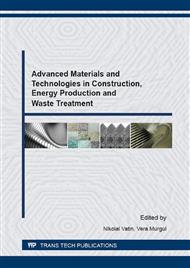[1]
M.A. Smirnov, Requirements for nano builders for high cement concrete, Technology of concrete, 9-10(2009) pp.86-88.
Google Scholar
[2]
S.F. Korenkova, T.V. Shein, Fundamentals and the concept of disposal of chemical wastes precipitation in the construction industry. Samara, 2004, p.208.
Google Scholar
[3]
SP 82-101-98. Preparation and use of mortars.
Google Scholar
[4]
M.M. Sychev, Inorganic materials, Math. USSR Academy of Sciences, 1(2008), pp.109-112.
Google Scholar
[5]
Y.S. Lipatov, V. Myshko, On the connection with the adhesion of the thermodynamic parameters of the polymers, Polymer Science, 5(1994), pp.1148-1151.
Google Scholar
[6]
E.M. Chernyshev, High-tech high-strength concrete: governance of their structure, Modern problems of building materials' and technology: mat. Int. Congress Science and Innovation in Construction, 2007, pp.616-620.
Google Scholar
[7]
SP 82-101-98. Preparation and use of mortars.
Google Scholar
[8]
GOST 31356-2007. Mixtures dry cement binder.
Google Scholar
[9]
V.E. Gul, V.N. Kuleznёv, Structure and mechanical properties of polymers: studies, manual for schools, Higher School, 2002, p.320.
Google Scholar
[10]
L. Cell, Finishing facades: Per. with Hung, M.: Stroyizdat, 1(1978), pp.184-206.
Google Scholar
[11]
L.E. Kuracra, GW De Puy, Concrete-Polymer Materials-Fourth Topical Report Brookhaven National Laboratory, New York, 2012, p.205.
Google Scholar
[12]
E.H. Merz, G.C. Claver, M.C., Baer, Fracture and mechanical properties of polymers, 22(2005), J. Polym. Sei, pp.326-330.
Google Scholar
[13]
R.A. Veselovsky, V.N. Kestelman., Tutorial polymer adhesion, China, Beijing, 2003, p.296.
Google Scholar
[14]
P.A. Veselovsky, G.V. Vysotsky, Y.S. Lipatov, Changing the properties of the polymer adhesives under the effect of surfactants, Academy of Sciences. 4(1999), pp.915-919.
Google Scholar
[15]
V.I. Solomatov, A.N. Boryshev, A.P. Proshin, Success of building materials: materials Anniversary Conference, Clusters in the structure and construction technology of composite materials, 2001, pp.73-80.
Google Scholar
[16]
R.C. Allen, L. Molderkem, Supermolekular structure of poly (ethylene oxide) fractions, J. Polym. Sci.: Polym. Phys. 20(1982), pp.438-443.
Google Scholar
[17]
K.N. Popov, M.B. Caddo, C. M. Puliaev, Dry mixes, StroyPROFIl, 4(2001), pp.34-36.
Google Scholar
[18]
O.P. Solonenko, Development of technologies for producing advanced composite powdered materials, functional coatings and surface layers controlled nano- and microstructure, Science and nanotechnology, Novosibirsk, 2007, pp.186-199.
Google Scholar
[19]
Richards, T.R. Hamzah and Yeang: Ecology of the Sky. Australia: Images (2001). The Millennium Ser.
Google Scholar
[20]
G. Vanger, Physico-chemical activation processes of cement dispersions, Kiev: Dumka, 2005, p.200.
Google Scholar
[21]
M. Jevrić, M. Knežević, J. Kalezić, N. Kopitović‐Vuković, I. Ćipranić, Application of fractal geometry in urban pattern design [Primjena fraktalne geometrije u projektiranju gradskog obrasca] Tehnicki Vjesnik, 21 (4) (2014) p.873‐879.
Google Scholar
[22]
M. Lazarevska, M. Knezevic, M. Cvetkovska, A. Trombeva‐Gavriloska, Application of artificial neural networks in civil engineering [Primjena umjetnih neuronskih mreža u građevinarstvu] Tehnicki Vjesnik, 21 (6) (2014) p.1353‐1359.
Google Scholar


